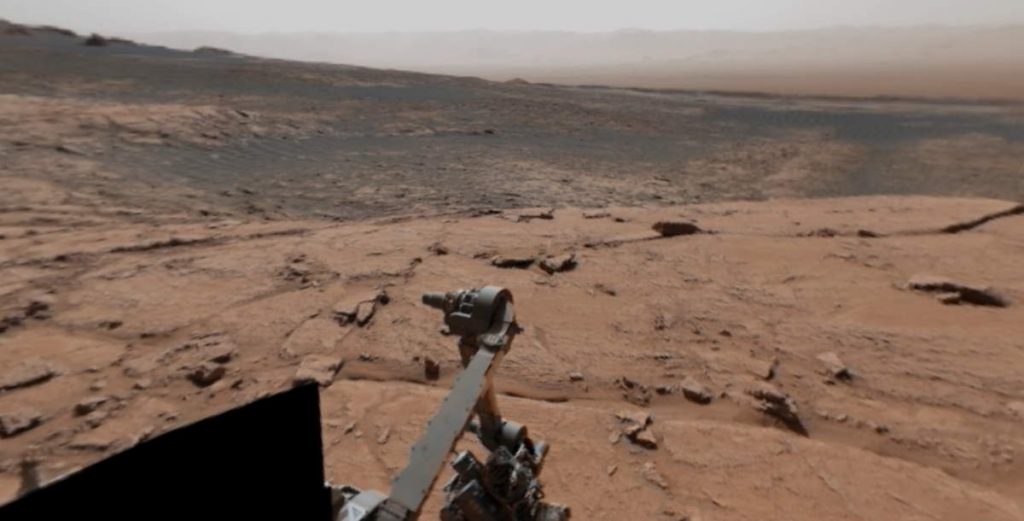Between November 24 and December 1, 2019, NASA’s Curiosity Rover has captured its highest-resolution Mars panorama yet. The composite contains 1.8 billion pixels of the Martian landscape and it is composed of more than 1,000 images.
Curiosity also captured a 650-million-pixel panorama that features the rover itself.
This panorama showcases “Glen Torridon,” a region on the side of Mount Sharp that NASA’s Curiosity Rover is exploring. The panorama was taken when the Curiosity team was out for the Thanksgiving holiday. Since the rover would be sitting still with few other tasks to do while it waited for the team to return and provide its next commands, the rover had a rare chance to image its surroundings several days in a row without moving.

The Curiosity Rover’s Mast Camera, or Mastcam, used its telephoto lens to produce the panorama and relied on its medium-angle lens to produce a lower-resolution panorama that includes the rover’s deck and its robotic arm.
Malin Space Science Systems in San Diego built and operates Mastcam. A division of Caltech, NASA’s Jet Propulsion Laboratory manages the Mars Science Laboratory mission for the agency’s Science Mission Directorate in Washington and built the Curiosity rover.

Narrated video of Curiosity Rover’s highest-resolution Mars panorama
NASA Curiosity Project Scientist Ashwin Vasavada guides this tour of the car-sized rover’s view of the Martian surface.
Transcript of the video:
Narrator: Ashwin Vasavada, NASA Curiosity Project Scientist
This is the largest and highest resolution Mars panorama the Curiosity Rover has ever taken. It’s made up of almost 1,200 individual images taken over four days.
The rover’s body is too close for the Mastcam’s telephoto lens. But we were able to capture the rover using the other Mastcam lens. The higher resolution version is nearly 1.8 billion pixels.
What I love about this panorama is that we can zoom way in and see details far in the distance. When you start to do that, you can see the rim of the crater we’re inside of, all the way to the north.
Here’s an impressive sight: 20 miles away is Slangpos crater, just inside Gale crater’s rim. End to end, Slangpos is three miles wide! Something huge must have struck here. Whenever I start to think that Mars looks familiar, sights like this dramatic impact crater remind me that we’re looking at a different planet.
Curiosity is exploring a clay-bearing region on the side of a mountain. This ancient landscape was the site of lakes and streams billions of years ago. They left their clues in the finely-layered, clay-rich rock.
This crumbling cliff is the edge of the Greenheugh Pediment. It’s a vast sheet of rock draped over the side of the mountain. It must have formed after the lakes disappeared and the mountain took its present shape. Did it once extend even farther out?
Curiosity looks a bit like an abstract painting here. That’s because this is a 360-degree perspective. The image is warped, like looking through a fisheye lens.
You can make out some amazing details on the rover itself.
This is the shadow of Curiosity’s mast.
Here’s RAD, an instrument that detects radiation from the sun and space. Thanks to RAD, we have a better idea of how to protect future astronauts on Mars.
Why are there severed tubes and wires on the rover? These tubes were part of the fluid cooling system that circulated throughout the spacecraft that flew the rover to Mars. These wires were like an umbilical cord for data. They were cut during landing.
In spite of all the dust, our sundial still tells us “to explore.”
Trailing behind the rover, you can see our tracks — including where we climbed up a hill. Even after seven years on Mars, Curiosity is not done making tracks yet.
Panoramas like this are like a window to another world.
Sources
- “NASA’s Curiosity Rover Snaps Its Highest-Resolution Mars Panorama Yet” on the NASA website
- Mars Curiosity Rover mission page on the NASA website
- Curiosity Rover on Wikipedia
- Video transcript: “Curiosity’s 1.8 Billion-Pixel Panorama on Mars” on the NASA Jet Propulsion Laboratory website
- Space Shuttle Endeavour’s Touchdown Meets Columbia’s Salute [An amazing photo from the past] - February 29, 2024
- Moon Landings: All-Time List [1966-2024] - February 23, 2024
- From Orbit to Ordinary: 10 Earthly Applications of Space Technology - January 23, 2024

